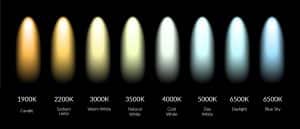Latest News
Understanding Colour Temperatures in Lighting: A Comprehensive Guide

Lighting is more than just a functional necessity. It’s an essential part of interior design and creating the right atmosphere. Colour temperature is one of the most critical aspects of lighting design. Understanding the differences between colour temperatures in lighting can help you make informed decisions about your lighting choices. In this article, we will explore what colour temperature is, how it is measured, and the different types of colour temperatures available.
What is Colour Temperature?
Colour temperature refers to the appearance of light produced by a light source. It is measured in Kelvin (K) and can range from warm to cool. A warm light source will have a lower colour temperature, while a cool light source will have a higher colour temperature. Warm light sources tend to emit a yellowish-orange light, while cool light sources emit a bluish-white light. The colour temperature can affect the mood and productivity of a space.

How is Colour Temperature Measured?
Colour temperature is measured in Kelvin (K), which is a unit of absolute temperature. The Kelvin scale starts at absolute zero, which is -273.15°C. The colour temperature of a light source is determined by comparing it to a black body radiator. A black body radiator is an object that absorbs all radiation that falls on it, and it emits radiation according to its temperature. When a light source is compared to a black body radiator, the temperature of the black body radiator that emits the same colour of light is used to determine the colour temperature of the light source.
The Different Types of Colour Temperatures
There are several different types of colour temperatures available, and each one has a different effect on the atmosphere of a space. Let’s take a closer look at the four most common types of colour temperatures.
Warm White (3000K)
Warm white is the most common colour temperature used in residential settings. It has a warm, yellowish-orange glow and is often used in living rooms, bedrooms, and dining rooms. It can also be used in commercial settings, such as restaurants and hotels, to create a warm and inviting atmosphere. In a retail environment, Whites may appear ‘washed-out’. Warm white colour temperature is not ideal for stores with white walls and ceilings.

Neutral White (3500K)
Neutral white has a slightly cooler appearance than warm white and is often used in workspaces and retail settings. It provides a balance between warm and cool tones and can help improve colour accuracy in tasks that require attention to detail. Whites still appear white. Reds and browns are vibrant.

Cool White (4000K)
Cool white light produces a bright and crisp light that mimics the colour of daylight. Can look clinical if compared to a 3000K store that is in direct proximity. It’s ideal for workspaces, garages, and outdoor areas. Cool white lighting can also be used in modern and minimalist spaces to create a clean and fresh ambiance.

Daylight (6500K)
Daylight lighting is the brightest and coolest lighting option. It’s ideal for spaces that require high levels of brightness, such as warehouses, factories, and hospitals. Daylight lighting can also be used in art studios and photography studios to provide accurate colour representation.
How to Choose the Right Colour Temperature for Your Space
Choosing the right colour temperature for your space depends on various factors such as the purpose of the space, the colour of the walls, and the mood you want to create.
- Consider the Purpose of the Space: The purpose of the space plays a crucial role in choosing the right colour temperature. For instance, warm white lighting is ideal for creating a relaxed ambiance in bedrooms and living rooms, while cool white lighting is perfect for workspaces and garages.
- Consider the Colour of the Walls: The colour of the walls can affect the colour temperature of the lighting. For instance, warm white lighting can make yellow walls look more vibrant, while cool white lighting can make blue walls appear cooler.
- Consider the Mood You Want to Create: Different colour temperatures can create different moods in a space. For instance, warm white lighting creates a cozy and intimate atmosphere, while cool white lighting creates a bright and energizing feel.
Choosing the right colour temperature in lighting is crucial for creating the desired atmosphere and mood in a space. Understanding the differences between colour temperatures can help you make an informed decision when choosing your lighting.
Want to learn more or need some assistance deciding what the right colour temperate is for you? Contact us to discuss your requirements.
We're a Casambi certified commissioning partner